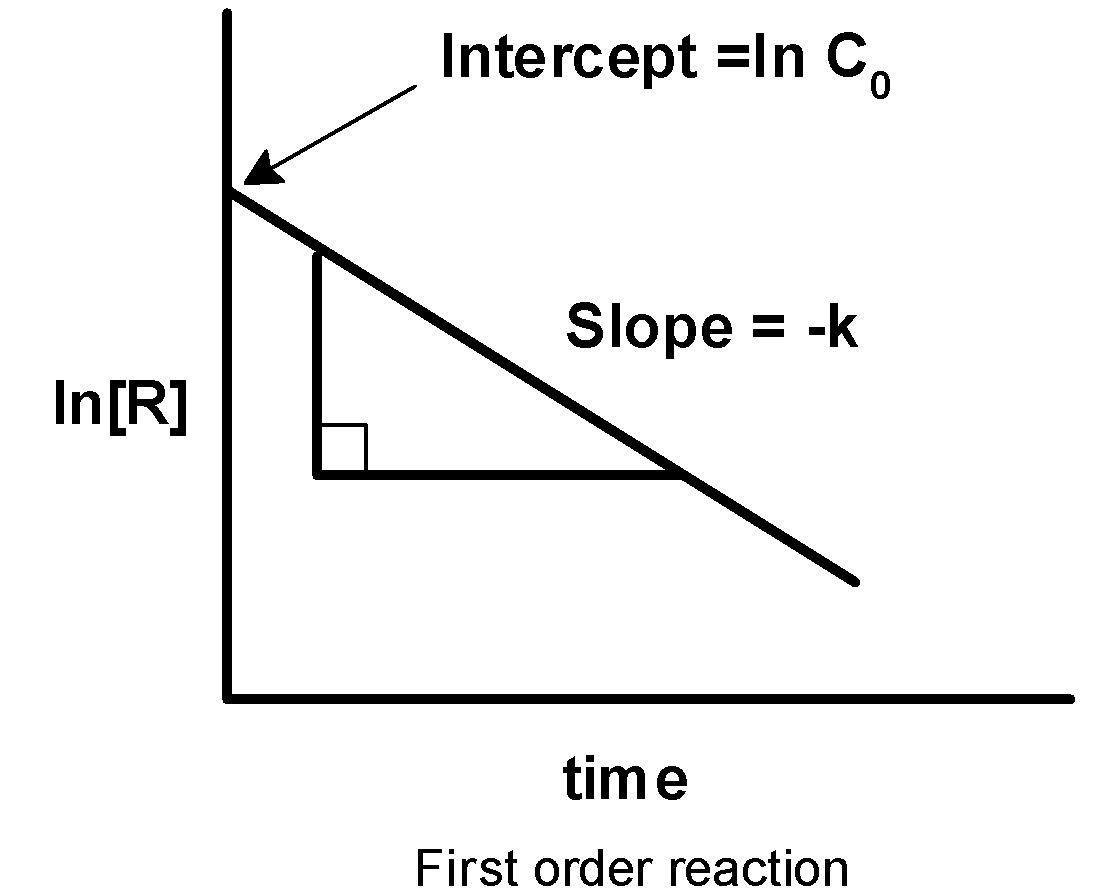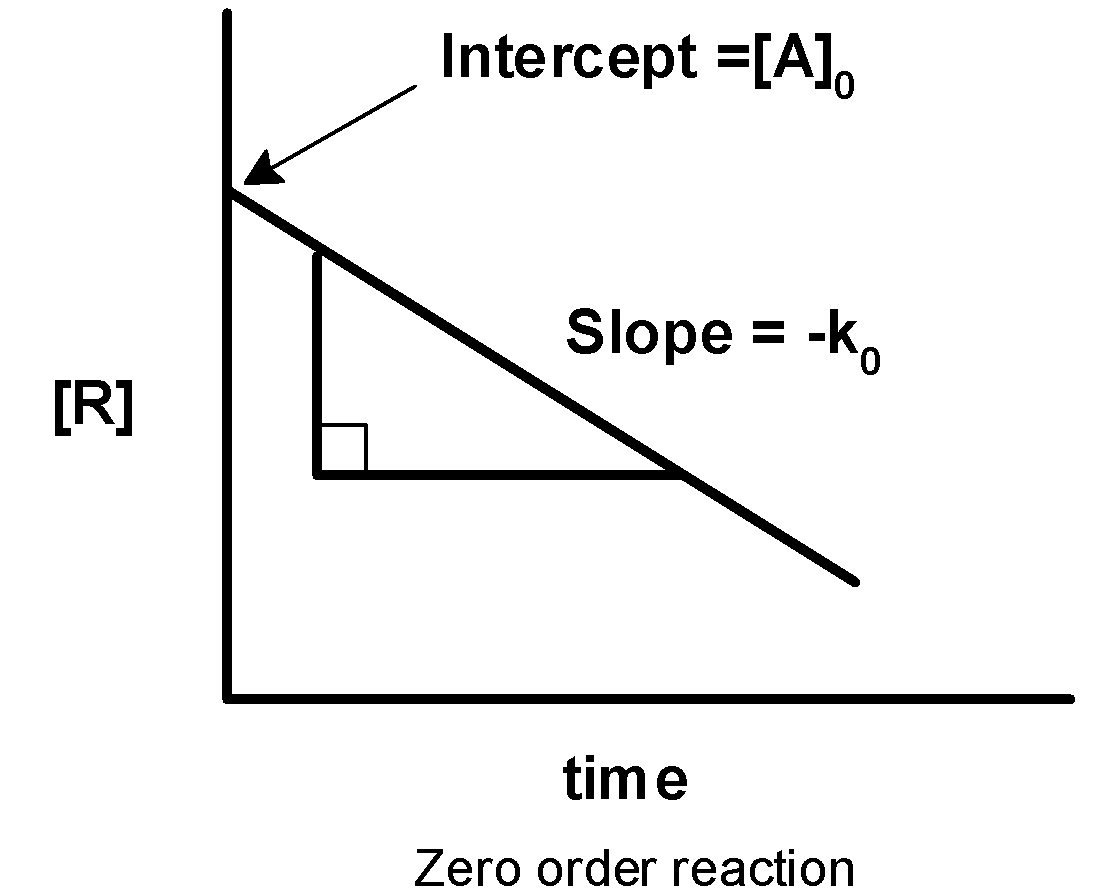Answer
405k+ views
Hint: The order of the reaction is the sum of the powers to which the concentration terms are raised in the rate –law expression. Thus reaction is said to be first order if the expression is of type $\text{ Rate = k}\left[ \text{A} \right]\text{ }$.
Complete step to step solution: We can reduce the integrated rate law by considering the change in the concentration and time interval. Thus integrated rate law can be further modified to fits in the straight line equation, $\text{ y = mx + c }$
-Where m is the slope and c is the intercept in the plot.
1) Let's consider a reaction of conversion of reactant A to the product P, $\text{ A}\to \text{ P }$. The rate of the reaction depends on the concentration of reactant A.
$\text{ Rate = k}\left[ \text{A} \right]\text{ }$
-On applying the integrated rate expression for the change of concentration from $\text{ }{{\left[ A \right]}_{0}}\text{ }$ $\text{ }\left[ A \right]\text{ }$ within the time interval of 0 to t, the integrated rate law is written as $\text{ }{{\text{k}}_{1}}\text{ = }\dfrac{1}{t}\ ln \dfrac{a}{a-x}\text{ }$. This shows that the concentration of a reactant in a first-order reaction decreases exponentially with time. The graph of concentration ‘c’ against the time ‘t’ is as shown below,
Graph
-The rate equation can be rearranged as,
$\begin{align}
& \text{ }{{\text{k}}_{1}}\text{t = }\ln a-\ln \text{ }\left( a-x \right) \\
& \Rightarrow \ln \left( a-x \right)\text{ = }-{{\text{k}}_{1}}\text{t + }\ln a \\
& \Rightarrow \ln c\text{ = }-{{\text{k}}_{1}}\text{t + }\ln {{c}_{0}} \\
\end{align}$
-The equation is similar to the straight-line equation $\text{ y = mx + c }$ .
-Therefore, on comparing we get that y is equal to $\ln c$ , the slope is equal to $\text{ - k }$ and intercept is equal to $\text{ }\ln {{c}_{0}}\text{ }$. Thus, on plotting the graph of $\ln c$ against the time ‘t’, we get the straight-line plot with the negative slope as shown below,

This represents the first-order reaction.
2) Let's consider a conversion of reactants to products where the rate of reaction is not affected by changes in concentration of one or more reactants. This is called the zero-order reaction. In such case for the conversion of $\text{ A}\to \text{ P }$, the rate expression is written as, $\text{ Rate = k}{{\left[ \text{A} \right]}^{0}}\text{ = k }$
-At the time $\text{ t = 0 }$ , the concentration is $\text{ }{{\left[ A \right]}_{0}}\text{ }$and at ‘t’ it changes to $\text{ }\left[ A \right]\text{ }$. The integrated rate law for the zero-order kinetic reaction is,
$\text{ }$ $\text{ }{{\text{k}}_{0}}\text{ = }\dfrac{1}{t}\left( \text{ }{{\left[ A \right]}_{0}}\text{ }-\text{ }\left[ A \right]\text{ } \right)\text{ }$
-Thus, the equation can be rearranged as,
$\begin{align}
& \text{ }{{\text{k}}_{0}}\text{ = }\dfrac{1}{t}\left( \text{ }{{\left[ A \right]}_{0}}\text{ }-\text{ }\left[ A \right]\text{ } \right)\text{ } \\
& \Rightarrow {{\text{k}}_{0}}t\text{ = }{{\left[ A \right]}_{0}}\text{ }-\text{ }\left[ A \right] \\
& \Rightarrow \left[ A \right]\text{ =}-{{\text{k}}_{0}}t\text{ + }{{\left[ A \right]}_{0}} \\
\end{align}$
-On comparing with the straight-line equation, the plot of $\text{ }\left[ A \right]\text{ }$against the time ‘t’ has the slope of $\text{ }-{{k}_{0}}$ and intercept equal to $\text{ }{{\left[ A \right]}_{0}}\text{ }$.
-Thus, when we plot a graph of the concentration of reactant against the time the graph is obtained as follows,

Thus, plot i) if first-order reaction and ii) is a zero-order reaction.
Hence, (A) is the correct option.
Note: Note that the rate of zero-order reaction is independent of the concentration of the reactant. Thus the rate of reaction for such reactions is determined by some other limiting factor such as the amount of catalyst used in catalytic reaction or the intensity of light absorbed in a photochemical reaction. The second-order kinetic reaction is given by the graph $\text{ }\dfrac{1}{[A]}$ against the t.
Complete step to step solution: We can reduce the integrated rate law by considering the change in the concentration and time interval. Thus integrated rate law can be further modified to fits in the straight line equation, $\text{ y = mx + c }$
-Where m is the slope and c is the intercept in the plot.
1) Let's consider a reaction of conversion of reactant A to the product P, $\text{ A}\to \text{ P }$. The rate of the reaction depends on the concentration of reactant A.
$\text{ Rate = k}\left[ \text{A} \right]\text{ }$
-On applying the integrated rate expression for the change of concentration from $\text{ }{{\left[ A \right]}_{0}}\text{ }$ $\text{ }\left[ A \right]\text{ }$ within the time interval of 0 to t, the integrated rate law is written as $\text{ }{{\text{k}}_{1}}\text{ = }\dfrac{1}{t}\ ln \dfrac{a}{a-x}\text{ }$. This shows that the concentration of a reactant in a first-order reaction decreases exponentially with time. The graph of concentration ‘c’ against the time ‘t’ is as shown below,
Graph
-The rate equation can be rearranged as,
$\begin{align}
& \text{ }{{\text{k}}_{1}}\text{t = }\ln a-\ln \text{ }\left( a-x \right) \\
& \Rightarrow \ln \left( a-x \right)\text{ = }-{{\text{k}}_{1}}\text{t + }\ln a \\
& \Rightarrow \ln c\text{ = }-{{\text{k}}_{1}}\text{t + }\ln {{c}_{0}} \\
\end{align}$
-The equation is similar to the straight-line equation $\text{ y = mx + c }$ .
-Therefore, on comparing we get that y is equal to $\ln c$ , the slope is equal to $\text{ - k }$ and intercept is equal to $\text{ }\ln {{c}_{0}}\text{ }$. Thus, on plotting the graph of $\ln c$ against the time ‘t’, we get the straight-line plot with the negative slope as shown below,

This represents the first-order reaction.
2) Let's consider a conversion of reactants to products where the rate of reaction is not affected by changes in concentration of one or more reactants. This is called the zero-order reaction. In such case for the conversion of $\text{ A}\to \text{ P }$, the rate expression is written as, $\text{ Rate = k}{{\left[ \text{A} \right]}^{0}}\text{ = k }$
-At the time $\text{ t = 0 }$ , the concentration is $\text{ }{{\left[ A \right]}_{0}}\text{ }$and at ‘t’ it changes to $\text{ }\left[ A \right]\text{ }$. The integrated rate law for the zero-order kinetic reaction is,
$\text{ }$ $\text{ }{{\text{k}}_{0}}\text{ = }\dfrac{1}{t}\left( \text{ }{{\left[ A \right]}_{0}}\text{ }-\text{ }\left[ A \right]\text{ } \right)\text{ }$
-Thus, the equation can be rearranged as,
$\begin{align}
& \text{ }{{\text{k}}_{0}}\text{ = }\dfrac{1}{t}\left( \text{ }{{\left[ A \right]}_{0}}\text{ }-\text{ }\left[ A \right]\text{ } \right)\text{ } \\
& \Rightarrow {{\text{k}}_{0}}t\text{ = }{{\left[ A \right]}_{0}}\text{ }-\text{ }\left[ A \right] \\
& \Rightarrow \left[ A \right]\text{ =}-{{\text{k}}_{0}}t\text{ + }{{\left[ A \right]}_{0}} \\
\end{align}$
-On comparing with the straight-line equation, the plot of $\text{ }\left[ A \right]\text{ }$against the time ‘t’ has the slope of $\text{ }-{{k}_{0}}$ and intercept equal to $\text{ }{{\left[ A \right]}_{0}}\text{ }$.
-Thus, when we plot a graph of the concentration of reactant against the time the graph is obtained as follows,

Thus, plot i) if first-order reaction and ii) is a zero-order reaction.
Hence, (A) is the correct option.
Note: Note that the rate of zero-order reaction is independent of the concentration of the reactant. Thus the rate of reaction for such reactions is determined by some other limiting factor such as the amount of catalyst used in catalytic reaction or the intensity of light absorbed in a photochemical reaction. The second-order kinetic reaction is given by the graph $\text{ }\dfrac{1}{[A]}$ against the t.
Recently Updated Pages
How many sigma and pi bonds are present in HCequiv class 11 chemistry CBSE

Why Are Noble Gases NonReactive class 11 chemistry CBSE

Let X and Y be the sets of all positive divisors of class 11 maths CBSE

Let x and y be 2 real numbers which satisfy the equations class 11 maths CBSE

Let x 4log 2sqrt 9k 1 + 7 and y dfrac132log 2sqrt5 class 11 maths CBSE

Let x22ax+b20 and x22bx+a20 be two equations Then the class 11 maths CBSE

Trending doubts
Fill the blanks with the suitable prepositions 1 The class 9 english CBSE

At which age domestication of animals started A Neolithic class 11 social science CBSE

Which are the Top 10 Largest Countries of the World?

Give 10 examples for herbs , shrubs , climbers , creepers

Difference between Prokaryotic cell and Eukaryotic class 11 biology CBSE

Difference Between Plant Cell and Animal Cell

Write a letter to the principal requesting him to grant class 10 english CBSE

Change the following sentences into negative and interrogative class 10 english CBSE

Fill in the blanks A 1 lakh ten thousand B 1 million class 9 maths CBSE





